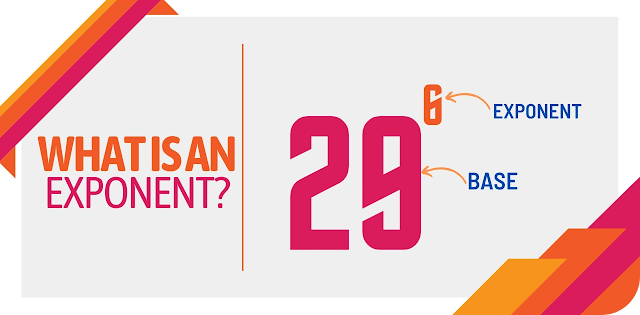An introduction to exponents explains the representation of very large numbers or very small numbers. Exponents are a value that is raised to a number. Exponents and powers both are related to each other. Exponents are introduced to the students in Class 6, 7 and 8.
The mass of the moon is 7,350,000,000,000,000,000,000,000 kg. But the value is so huge, that we cannot read it easily. Thus, to make it simple reading and writing of such huge numbers, exponents were introduced.
 |
| An Introduction To Exponents | Definition | Exponents and Powers |
What are Exponents?
An expression that consists of a repeated power of multiplication of the same factor is called an exponent. It is also called raised to the power of a number or indices.
Consider an example like 52, the number 5 is called the base, whereas 2 is the exponent of the expression.
The value of the expression is derived by multiplying the base as many times as the number of power. In the example above, the power is 2, thus the value becomes 5 x 5 = 25.
Types of Exponents
Exponents can be divided into four types based on the number in the power. They are:
- Positive exponent
- Negative exponent
- Zero exponent
- Rational exponent
Positive Exponents
Positive exponents can be simplified just by multiplying the base to itself the number of times indicated by the exponent/power.
Negative Exponents
A negative exponent can be simplified by placing 1 in the numerator and the base along with the exponent in the denominator of a fraction.
Zero Exponents
Zero exponents Any expression with the exponent as 0 is equal to 1 and no need to consider the base value during simplification.
Rational Exponents
Rational or fractional exponents will become radical or roots. For example, 31/3 can be written as 3root of 3, 65/2 can be written as 2 root (or square root) of 6 raises to the power 5.
Introduction to Exponents Examples
Let us consider a few more examples to understand the concepts in a better manner.
Example 1: Express the number 245,000,000 into the exponent form.
Solution: The term can be written in the form of 2.45 × 108.
Example 2: What is the exponential form of 8 in the expression given below-
23
Solution: The exponential form is the power in the expression. In the given expression the power of the base is 3. Hence 3 is the Index/ Power.
Also, the value of the expression equals 8.
What are Negative Powers?
Let us now learn about the negative power.
The negative power is almost similar to the positive power of the exponent. The only change in the negative power is that the value of the expression is the reciprocal of the value obtained in the positive case.
Take an Example:
The negative power can also be written as-
.
Negative Powers Examples
Let us have a look at few more examples-
Example:
Find the value of the given expression (in fractional form)
(i)
(ii)
(iii)
Solution:
(i)
The expression can be written as-
(ii)
The expression can be written as-
(iii)
The expression can be written as-
Relation Between Positive and the Negative Power
Let us consider a base number to be a, and the power to be x,
The relation between the positive and the negative expression is given as-
Value of expression when the base value is 0 or 1:
0 and 1 are the only power that gives the same value, i.e. 0 and 1 respectively, for different exponent values.
Such as
Negative Powers of 0 and 1
The negative power of 0 does not exist in nature. As the negative power would lead to making the denominator to be 0, therefore the negative power of 0 cannot exist in nature.
Whereas the negative power of 1 exists in nature and is equal to the positive power of 1, as it would also result in the value being equal to 1.
In General form, we can write as-
(where ‘a’ is a positive number)
( where ‘a’ can take positive as well as negative value both)
When the power is 0-
When the exponent value is equal to 0, the value of the expression is always equal to 1.
What about
?
Based on the explanation stated above the value of the expression can either take 0 or 1.
But the value of such an expression cannot take 2 values at a time. Therefore the correct value for
is equal to 1.
Laws of Exponents
The laws of exponents are:
| Product law | am.an = am+n |
| Quotient law | am/an = am-n |
| Power raised to a power | (am)n = amn |
| Product to a power | an.bn = (ab)n |
| Quotient to a power | an/bn = (a/b)n |
| Zero power | a0 = 1 |
| Negative exponent | a-m = 1/am |
| Fraction exponent | a1/n = n√a |
Problems and Solutions
Example 1:
What is the exponential form of
? Mention its base and exponent.Solution:
=
In the above example, “2” is the base which is in 8 times repeated multiplication, equals “
”.So, the base is “2” and the exponent is “8”.
Example 2:
Which one is smaller
or?Solution:
First we need to calculate the value of the given expression.
=
and,
==Thus
andTherefore,
Practice Questions
Q.1: Write the following exponents using repeated multiplication and find the value
- 43
- 26
- 55
- 72
Q.2: Rewrite the following expressions using exponents.
- 3 x 3 x 3
- 8 x 8 x 8 x 8 x 8
- 6 × 6 × 6 × 6 × 6
- 4 × 4 × 4 × 4 × 4 × 4 × 4